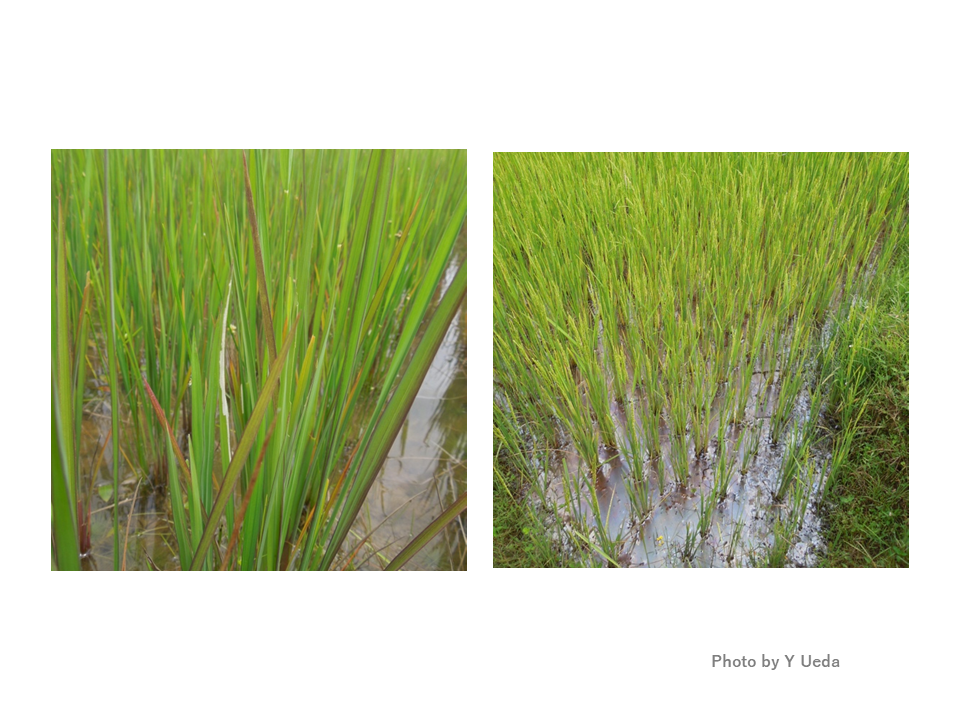Pick Up
832. Magnesium Fertilization Reduces Iron Toxicity-induced Leaf Bronzing in Rice

832. Magnesium Fertilization Reduces Iron Toxicity-induced Leaf Bronzing in Rice
Iron toxicity is a physiological disorder specific to rice grown under waterlogged conditions and occurs in many regions of Southeast Asia and Africa. It has been reported to reduce rice yields by 15% or more in many regions by causing growth retardation and a leaf symptom known as leaf bronzing. Although the problem of iron toxicity has been recognized for more than half a century, little progress has been made in identifying the factors important in its tolerance and the key genes for crop improvement. The degree of iron toxicity is known to be influenced by multiple factors, including other nutrients and soil properties. Potting and hydroponic experiments have shown that potassium fertilization and the application of a calcium-magnesium fertilizer mixture called dolomite can reduce iron toxicity. However, very little information was available on the effects of these nutrients on rice growth and the formation of visible disorders in actual iron toxic fields, and the mechanisms by which these nutrients reduce iron toxicity.
In collaboration with the University of Antananarivo, Madagascar, and Cranfield University, UK, we investigated the effect of magnesium fertilization on the formation of iron toxicity-induced leaf bronzing in iron toxic fields in the Central Highlands of Madagascar, and also conducted greenhouse experiments in Japan. In addition, the effects of magnesium on a wide range of gene expression during iron toxicity were studied using a technique called RNA sequencing (RNA-Seq) analysis.
In the iron toxic field of Madagascar, it has been confirmed that the application of magnesium fertilizer significantly reduces the formation of leaf bronzing induced by iron toxicity throughout the growth stages. Moreover, magnesium fertilization revealed two types of resistance mechanisms: the “exclusion tolerance” mechanism, which suppresses the excessive absorption of iron in the plants in the field, and the “tissue-tolerance” mechanism, which improves the resistance to excessive iron in the tissues, both leading to the reduction of leaf bronzing. In cultivation experiments using hydroponic solutions, it was observed that magnesium fertilization reduced iron concentration in older tissues while reducing visible symptoms without reducing iron concentration in new leaves, indicating that magnesium fertilization provides both exclusion and tissue-tolerance mechanisms. On the other hand, calcium fertilization did not affect the formation of visible symptoms, indicating that the effect is specific to magnesium and cannot be explained simply by ion competition.
A comprehensive study of gene expression in hydroponically grown plants using a technique called RNA-Seq suggested that magnesium fertilization in roots can significantly alter gene expression in leaves, leading to a reduction in visible symptoms. In addition, many binding sequences for specific proteins were found in the regulatory regions of genes affected by magnesium fertilization, suggesting a molecular mechanism involved in magnesium-induced reduction of visible symptoms.
In conclusion, our results indicate that magnesium fertilization is effective in reducing visible symptoms induced by iron toxicity. We have also shown that magnesium supply confers both exclusion and tissue-tolerance mechanisms, and that magnesium fertilization reduces visible symptoms through changes gene expression in leaves. Thus, bronzing induced by iron toxicity is affected not only by iron but also by magnesium supply, revealing one aspect of a complex mechanism of iron toxicity tolerance. This study may provide clues to elucidate the molecular mechanisms of the iron toxicity response and may be useful for the development of plants with improved tolerance to iron toxicity.
Photo caption:
Photo 1 (left) Iron toxic field in the Central Highlands of Madagascar
Photo 2 (right) Visible symptom caused by iron toxicity
Reference
Rajonandraina, T., Ueda, Y., Wissuwa, M., Kirk, J.D.K., Rakotoson, T., Manwaring, H., Andriamananjara, A., Razafimbelo, T. (2023) Magnesium supply alleviates iron toxicity-induced leaf bronzing in rice through exclusion and tissue-tolerance mechanisms. Frontiers in Plant Science 14, 1213456. https://doi.org/10.3389/fpls.2023.1213456
Contributors: UEDA Yoshiaki (Crop, Livestock and Environment Division), NAKASHIMA Kazuo (Food Program)
